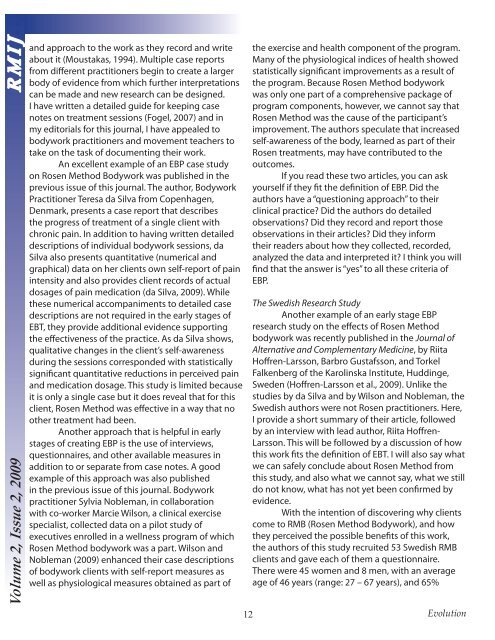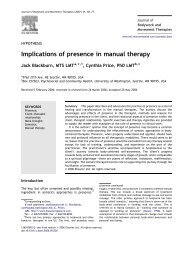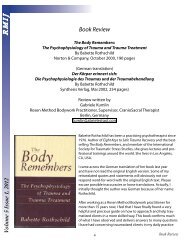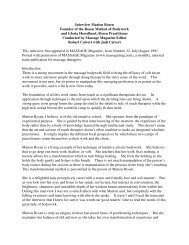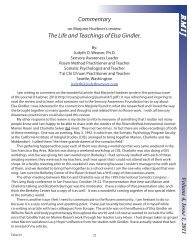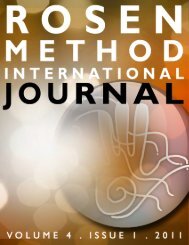RMIJ ... - Rosen Journal
RMIJ ... - Rosen Journal
RMIJ ... - Rosen Journal
You also want an ePaper? Increase the reach of your titles
YUMPU automatically turns print PDFs into web optimized ePapers that Google loves.
<strong>RMIJ</strong>...<br />
Volume 2, Issue 2, 2009<br />
and approach to the work as they record and write<br />
about it (Moustakas, 1994). Multiple case reports<br />
from different practitioners begin to create a larger<br />
body of evidence from which further interpretations<br />
can be made and new research can be designed.<br />
I have written a detailed guide for keeping case<br />
notes on treatment sessions (Fogel, 2007) and in<br />
my editorials for this journal, I have appealed to<br />
bodywork practitioners and movement teachers to<br />
take on the task of documenting their work.<br />
An excellent example of an EBP case study<br />
on <strong>Rosen</strong> Method Bodywork was published in the<br />
previous issue of this journal. The author, Bodywork<br />
Practitioner Teresa da Silva from Copenhagen,<br />
Denmark, presents a case report that describes<br />
the progress of treatment of a single client with<br />
chronic pain. In addition to having written detailed<br />
descriptions of individual bodywork sessions, da<br />
Silva also presents quantitative (numerical and<br />
graphical) data on her clients own self-report of pain<br />
intensity and also provides client records of actual<br />
dosages of pain medication (da Silva, 2009). While<br />
these numerical accompaniments to detailed case<br />
descriptions are not required in the early stages of<br />
EBT, they provide additional evidence supporting<br />
the effectiveness of the practice. As da Silva shows,<br />
qualitative changes in the client’s self-awareness<br />
during the sessions corresponded with statistically<br />
significant quantitative reductions in perceived pain<br />
and medication dosage. This study is limited because<br />
it is only a single case but it does reveal that for this<br />
client, <strong>Rosen</strong> Method was effective in a way that no<br />
other treatment had been.<br />
Another approach that is helpful in early<br />
stages of creating EBP is the use of interviews,<br />
questionnaires, and other available measures in<br />
addition to or separate from case notes. A good<br />
example of this approach was also published<br />
in the previous issue of this journal. Bodywork<br />
practitioner Sylvia Nobleman, in collaboration<br />
with co-worker Marcie Wilson, a clinical exercise<br />
specialist, collected data on a pilot study of<br />
executives enrolled in a wellness program of which<br />
<strong>Rosen</strong> Method bodywork was a part. Wilson and<br />
Nobleman (2009) enhanced their case descriptions<br />
of bodywork clients with self-report measures as<br />
well as physiological measures obtained as part of<br />
the exercise and health component of the program.<br />
Many of the physiological indices of health showed<br />
statistically significant improvements as a result of<br />
the program. Because <strong>Rosen</strong> Method bodywork<br />
was only one part of a comprehensive package of<br />
program components, however, we cannot say that<br />
<strong>Rosen</strong> Method was the cause of the participant’s<br />
improvement. The authors speculate that increased<br />
self-awareness of the body, learned as part of their<br />
<strong>Rosen</strong> treatments, may have contributed to the<br />
outcomes.<br />
If you read these two articles, you can ask<br />
yourself if they fit the definition of EBP. Did the<br />
authors have a “questioning approach” to their<br />
clinical practice? Did the authors do detailed<br />
observations? Did they record and report those<br />
observations in their articles? Did they inform<br />
their readers about how they collected, recorded,<br />
analyzed the data and interpreted it? I think you will<br />
find that the answer is “yes” to all these criteria of<br />
EBP.<br />
The Swedish Research Study<br />
Another example of an early stage EBP<br />
research study on the effects of <strong>Rosen</strong> Method<br />
bodywork was recently published in the <strong>Journal</strong> of<br />
Alternative and Complementary Medicine, by Riita<br />
Hoffren-Larsson, Barbro Gustafsson, and Torkel<br />
Falkenberg of the Karolinska Institute, Huddinge,<br />
Sweden (Hoffren-Larsson et al., 2009). Unlike the<br />
studies by da Silva and by Wilson and Nobleman, the<br />
Swedish authors were not <strong>Rosen</strong> practitioners. Here,<br />
I provide a short summary of their article, followed<br />
by an interview with lead author, Riita Hoffren-<br />
Larsson. This will be followed by a discussion of how<br />
this work fits the definition of EBT. I will also say what<br />
we can safely conclude about <strong>Rosen</strong> Method from<br />
this study, and also what we cannot say, what we still<br />
do not know, what has not yet been confirmed by<br />
evidence.<br />
With the intention of discovering why clients<br />
come to RMB (<strong>Rosen</strong> Method Bodywork), and how<br />
they perceived the possible benefits of this work,<br />
the authors of this study recruited 53 Swedish RMB<br />
clients and gave each of them a questionnaire.<br />
There were 45 women and 8 men, with an average<br />
age of 46 years (range: 27 – 67 years), and 65%<br />
12 Evolution


